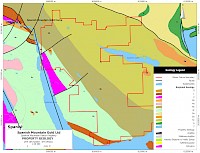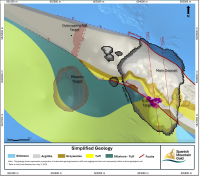The rocks underlying the Spanish Mountain property have been mapped as middle to upper Triassic units within the Quesnel Terrane. The regional stratigraphy is complex but in the broadest of terms the lower clastic sedimentary and upper volcanic packages can be correlated with parts of the Nicola Group (to the south) or the Takla Group (to the north). The area of principal interest is underlain by argillite, mudstone, siltstone, greywacke and conglomerate.
The lithological model was developed based on data from the extensive re-logging of drill core, a work program that examined 170,000 m of historical drilling that was completed between 2023 and 2024. In addition, a detailed geochemical classification of 56,550 previously sampled intervals was undertaken to refine stratigraphy through lithogeochemistry. Mineralization domains are modelled by identifying zones with gold values greater than 0.3 g/t over a minimum width of 3 m. Two primary styles of mineralization were recognized. Early mineralization includes disseminated stratabound mineralization in argillite-bearing lithologies. Late mineralization includes gold associated with late-stage quartz veins. Three high-confidence faults were modelled, including the North Fault, South Fault, and Fault 1. The Main Block is bound by the North and South Faults, representing significant discontinuities in stratigraphy and mineralization. Within the Main Block, Fault 1 introduces a minor offset in the main block.
These rocks have been weakly metamorphosed, and complexly folded and faulted. Disseminated and vein-controlled gold mineralization occurs in all rock types. The mineralization is contained within several statigraphically and structurally controlled zones.
Sediment-Hosted Vein (SHV) Deposit
The Spanish Mountain gold deposit is classified as a sediment-hosted vein (SHV) deposit, as defined by Klipfel (2005). Key characteristics of SHV deposits include the following:
- Hosted in extensive belts of shale and siltstone sedimentary rocks of up to thousands of square kilometres.
- Rocks originally deposited in sequences along the edges of continents known as passive margin settings.
- The sedimentary belts have typically undergone fold/thrust deformation.
- Other important tectonic and structural indicators include proximity to continental basement, the presence of cross structures and multiple episodes of alteration.
- The presence of quartz and quartz-carbonate veins.
- Wide spread regional carbonate alteration is common. The carbonate alteration is typically ankerite, dolomite or siderite, as porphyroblasts and/or as pervasive, fine-grained carbonate.
- Widespread sericitic alteration in both argillite and siltstone.
- Knots and "nests" of pyrite along with large pyrite cubes and fine-grained disseminated pyrite throughout the host rocks, and in argillites in particular.
- They are often simple gold systems. Sometimes trace elements associated with SHV deposits are arsenic (as arsenopyrite), tungsten, bismuth and tellurium. Generally there is a paucity of copper, lead and zinc sulphides, but minor amounts occur in a few deposits.
- The deposits can be associated with prolific placer gold fields.
- Granitic rocks commonly, but not always, occur in spatial association with the deposit. The timing of granitic intrusion can be before or after mineralization.
SHV deposits are some of the largest in the world with many of the largest located in Asia, especially in Russia. Examples include Muruntau (more than 80 Moz, Sukhoy Log (more than 20 Moz), Amantaytau, Olympiada (both more than 5 Moz), andothers. In Australia they include Bendigo (more than 20 Moz), Ballarat, Fosterville, and Stawell. In North America, small to medium deposits occur in the Meguma Terrane of Nova Scotia and in the southern half of the Seward Peninsula in Alaska (Klipfel 2005).
Spanish Mountain shows many of the features common to these deposits (Klipfel 2007), including some of the structural characteristics, regional extent of alteration, alteration mineralogy, mineralization style and gold grade. In addition, the metal chemistry is gold without an association of other trace elements. There is also a lack of significant base metal sulphides.



